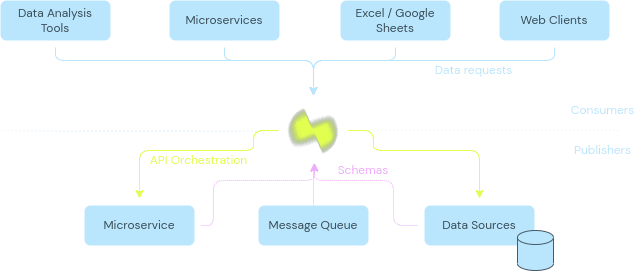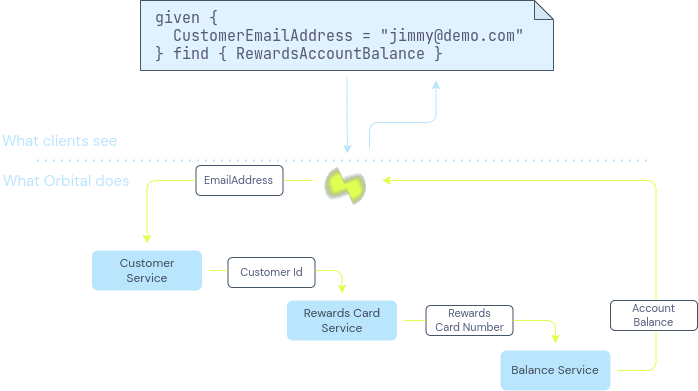Introduction
Overview
Introduction
Modern organisations have multiple services and data sources - and with the move to microservices, this is on the rise.
However, while microservices are great, lots of services means lots of plumbing - which can quickly become brittle, making change difficult.
Orbital addresses this by automatically building and maintaining the integration between services, allowing services to stay decoupled from one another.
Consumer-centric integration
Orbital allows consumers to ask for the data they need, without specifying how to fetch it. Orbital generates the integration on-the-fly, using Taxi metadata embedded inside API specs.
This means that as API’s evolve, or as services are deployed or replaced, Orbital’s integrations automatically adapt, without requiring clients to change.

given {
emailAddress : EmailAddress = "jimmy@demo.com"
} find {
lastPurchase: {
@Format("dd/MMM/yyyy hh:mm:ss")
date : LastPurchaseDate
value : LastPurchaseValue
}
accountBalance : AccountBalance
}Orbital leverages schemas to automatically work out which services to call, and sequences them together to pass data from service to service, in order to discover the data clients need.

Integration that adapts with you
Services publish their schemas to Orbital, which describe their API’s and the data they provide.
Orbital uses this to build integration plans on-the-fly. This means that as your API’s change, Orbital automatically adapts, keeping clients protected from the change.
There’s no resolvers to update, Swagger SDK’s to rebuild, or API consumer contracts to refactor.
Orbital provides several ways for services to generate and publish their schema - hand-crafted schema’s, automatically generated at runtime, git backed in a central repository, or a mix of the three.
Find out more about schema strategies here
Semantic data schemas
Semantic schemas describe the meaning of their data in a way that’s sharable between systems.
| Schema attribute | What it tells us |
|---|---|
| Field name | Where to find information |
| Data type | How to read / write from the wire |
| ??? | What the data means in a broader ecosystem |
Today's schemas aren't semantic
Today, when we connect two systems together, an engineer has to build a mental model between the field name and the data they’re looking for.
// The id attribute in the Customer model from the Accounts sytems
// is the same as the custId attribute in the Purchase model from sales system
namespace accounts {
model Customer {
id : String // This is the same...
}
}
namespace sales {
model Purchase {
custId : String //...as this
}
}This has a few shortcomings:
- The mapping of
Customer.id -> Purchase.custIdgets embedded in code. If a field name changes, this breaks, making change difficult. - The mapping gets repeated for every consumer.
This mapping exercise takes place because traditional schemas don’t provide rich enough information to link on anything else.
If a field gets renamed? 💥 Boom! Breakdown city.
What’s missing is semantic metadata - something that describes how data between systems relates to one another, independent of field names.
Defining semantic metadata
Taxi is a language for defining and embedded semantic metadata.
It allows us to represent how data links between systems, without relying on field names.
// Define the semantic concept
type CustomerId inherits String
namespace accounts {
model Customer {
id : CustomerId // This is the same...
}
}
namespace sales {
model Purchase {
custId : CustomerId //...as this
}
}These semantic types are defined in Taxi. You can choose to either describe your APIs using Taxi (which has first class support for semantic metadata), or embed Taxi metadata within other schema languages, such as OpenAPI:
# An extract of the ShoppingCartApi OpenAPI spec:
components:
schemas:
Customer:
properties:
id: # Field name
x-taxi-type: # <-- Taxi extension
name: CustomerId # <-- Semantic type
type: string# An extract of the CustomerApi OpenAPI spec:
components:
schemas:
Purchase:
properties:
custId: # Field name
x-taxi-type: # <-- Taxi extension
name: CustomerId # <-- Semantic type
type: stringSemantic driven integration
Once we understand how data between systems relates, we can use the rest of the API specs to work out how to connect them together.
For example, given a Purchase from our Orders system, we can understand how to look up information about the customer from the Customer system.
Orbital performs this integration for us.
By sending a request in TaxiQL, we can ask for data, without specifying how data relates, or which systems to get them from.
find { Purchases[] } as {
purchaseId : PurchaseId // Comes from the Purchase object
customerName : CustomerName // Looked up by calling the Customer service
}This means that systems are free to update field names, replace databases with APIs, APIs with databases, etc. Consumers remain unaffected.
Find out more about Semantic data and Taxi on the Taxi website
